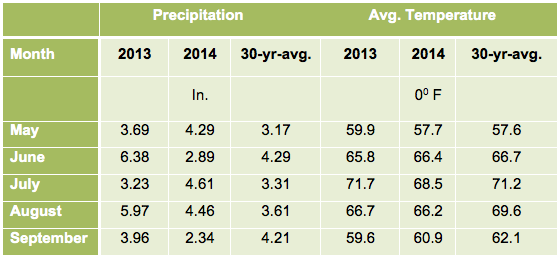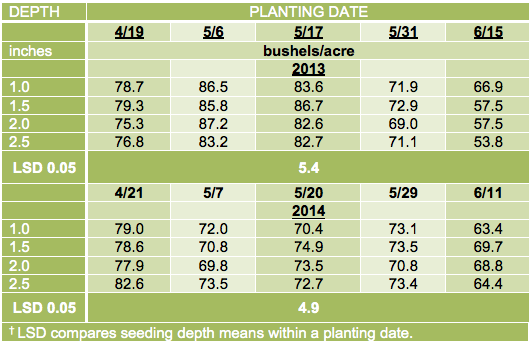Bill Cox, School of Integrative Plant Science, Soil and Crop Sciences Section and Phil Atkins, New York Seed Improvement Program, Cornell University
It is generally recognized that the optimum soybean planting date range in NY is from ~May 10-May 25 and the optimum seeding depth is ~1.5 inches on most planting dates. Some growers, however, have had success by planting soybeans in late April, before planting the corn crop. In addition, a late April or early May soybean planting date greatly improves the probability of timely wheat planting, if soybean growers are in a corn-soybean-wheat rotation. We conducted small-plot research at the Aurora Research Farm in 2013 and 2014 to answer three questions concerning soybean planting: 1) Can soybean be safely planted in late April in the Finger Lakes region and western NY (regions where there is typically no frost after May 15) without a yield penalty, 2) does the 1.5-inch seeding depth fit all planting dates, and 3) should a Group II or Group I variety be selected, if the planting date is delayed until mid-June.
We planted a mid-Group II (AG2431) and a late Group I (AG1832) variety on April 19, May 6, May 17, June 1 and June 15 in 2013 and on April 21, May 7, May 20, May 29, and June 11 in 2014 at 1.0, 1.5, 2.0, and 2.5 inch seeding depths at the Aurora Research Farm in Cayuga County. Soybeans were planted in 15-inch rows with a White row crop planter at ~170,000 seeds/acre. We evaluated early plant establishment at ~1st -2nd trifoliate stage (~V2-V3) about 10 to 35 days after planting, depending upon planting date. Each planting date x variety x seeding depth plot was harvested when moistures were less than 16% (September 27, October 3, and October 15 in 2013; and September 29 and October 13 in 2014.). Growing conditions were mostly similar across years, with 2013 somewhat warmer and wetter, but drought stress did not occur in either year (Table 1).

Early plant populations had a significant year x planting date x seeding depth interaction (P=0.09), indicating that the optimum seeding depth varied across planting dates within years (Table 2). In 2013, the 1-inch seeding depth consistently had the highest early plant populations at ~135,000-145,000 plants/acre (~80-85% early plant establishment) for all planting dates. In 2014, however, the 1.0 inch seeding depth had early plant populations of only ~103,000 plants/acre on the May 20 planting date (~60% establishment) because of an extended dry period after this planting date. Likewise, the 2.5 inch seeding depth at the late April planting date had the lowest early plant populations in 2013 (~102,000 plants/acre or ~60% establishment) and in 2014 (~119,000 plants/acre or ~75% establishment), associated with the cool conditions after planting, but mostly similar early plant populations on all May planting dates. The 2.5 inch depth also had the lowest early plant populations on the June planting dates (~111,000 plants/acre or ~65% establishment in 2013 and ~119,000 plants/acre or ~70% establishment in 2014) probably because heavy rains after planting resulted in significant soil crusting before emergence on those dates.

Seed yield did have a year x planting date x seeding depth interaction, but mostly because of the mid-June planting dates (Table 3). Seed yields did not vary with planting depth across the first four planting dates in either year, despite early plant populations of only 101,800 plants/acre at the 2.5 inch seeding depth on the April 19 planting date in 2013 and of only 103,075 plants/acre at the 1.0 inch seeding depth on May 20 in 2014. Seed yields, however, were lower on the June planting dates at the 2.5 inch depth in 2013 and 2014 (~20% in 2013 and ~8% in 2014) and at the 1.0 inch depth in 2014 (9% less), probably associated with low early plant populations.

Seed yield also had a year x planting date x variety interaction (Fig. 1 and Fig.2). The Group II variety yielded the highest at the April planting date and June planting date in both years. The Group I and Group II varieties yielded the same on all three May planting dates. Yield showed a quadratic response to planting date in 2013 with lower yields at the April planting date, maximum yield observed between the May 6 and May 17 planting dates, and the lowest yield for the June 15 planting date (Table 3 and Fig.1). In 2014, yield showed a negative linear response to planting date with maximum yield observed at the April planting date, similar yields among the May planting dates, and the lowest yield for the June 11 planting date (Table 3 and Fig.2). Soybean yields planted in late April compared to mid- June averaged ~30% higher in 2013 and ~20% higher in 2014.


Conclusion
When averaged across years, varieties and planting dates, a negative linear relationship existed between early plant populations and seeding depth, indicating that the 1.0 inch seeding depth had the highest overall early plant populations (~133,000 plants/acre compared with ~123,750 plants/acre at the 2.5 inch depth). Nevertheless, the year x planting date x seeding depth interaction, in part because the 1.0 inch seeding depth had the lowest early plant populations compared to all seeding depths on the May 20 planting date in 2014, indicates that the 1.0 inch depth may result in poor early stand establishment when an extended dry period follows planting. Likewise, lower early plant populations at the 2.5 inch depth on the April and June planting dates, but similar early plant populations on the May planting dates, indicates that 2.5 inch depth is too deep under cool conditions, or if soil crusting occurs after planting before emergence. Consequently, the 1.5 to 2.0 inch depth range appears to be the optimum for early plant establishment for most planting dates.
Plant populations, however, do not correlate with yield in most situations, unless final stands are less than ~114,000 plants /acre under NY growing conditions (Cox and Atkins, What’s Cropping Up, Vol.21, No.2, p. 5-6). Consequently, the relationship between yield and seeding depth was neither linear nor quadratic when averaged across years, varieties, and planting dates. Soybeans have a tremendous ability to compensate or fill in when early plant populations are low, which is reflected in similar yields among seeding depths, despite low plant populations at the 2.5 inch depth for the April planting dates in both years and for the 1.0 inch depth for the mid-May planting date in 2014.. Soybeans, however, did not compensate for the low plant populations at the June planting dates, as evidenced by lower yield at the 2.5 inch depth in 2013 (~20% less than the highest yield on that date) and at the 1.0 inch and 2.5 inch seeding depths in 2014 (8-9% lower than the highest yield on that date). Perhaps, soybeans have less time to compensate for lower plant populations if planted in mid-June in NY.
When averaged across years, varieties, and seeding depths, yield showed a quadratic yield response to planting date with maximum yields occurring at the late April and early May planting dates. The year x variety by planting date interaction for yield indicated that a Group I or Group II variety planted in early or mid-May yielded highest in 2013 but a Group II variety planted in late April yielded highest in 2014. Yields decreased for both varieties at the late May planting date in 2013 but yields were the same across all May planting dates for both varieties in 2014. Yield of the Group II vs. Group I variety was higher for the June planting date in both years. The yield data indicate that a Group II variety planted sometime between April 25 and May 10 appears to be the optimum range compared to the general belief of the May 10 to May 25 range. Growers who have a corn-soybean-wheat rotation in some fields may wish to consider planting a Group II variety ahead of corn or simultaneously with corn in late April or early May in those fields, especially if timely planting of wheat is a concern. The 20-to 30% higher yields for late-April compared to mid-June planted soybeans may prompt growers who do not have wheat in their rotation to consider planting soybeans in late April or early May, simultaneous with corn planting. Keep in mind that this study was conducted on a well-drained soil in a region of the state where spring frosts do not typically occur after May 15. Late April-planted soybeans are not recommended for poorly drained soils or on farms where frost can occur after May 15.

